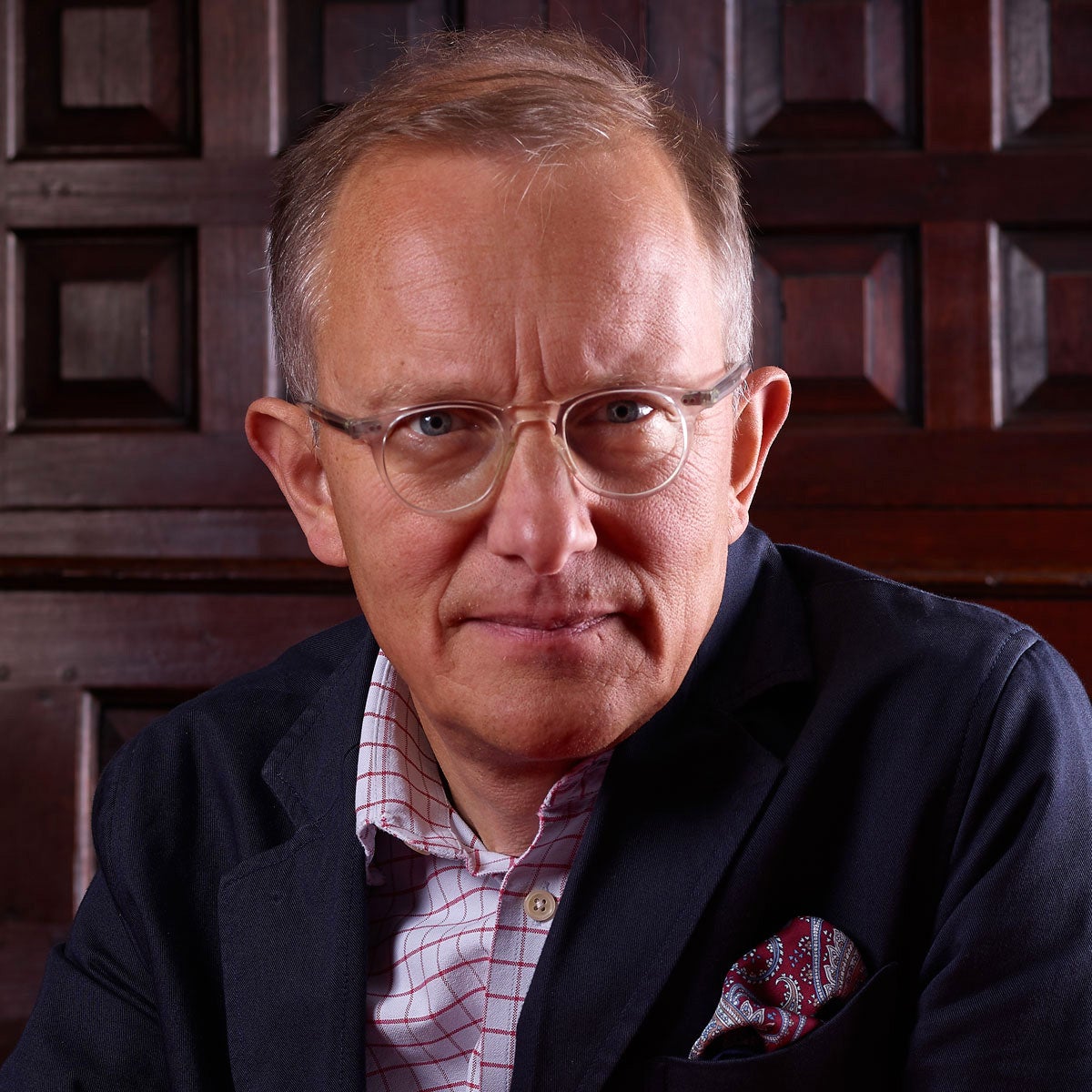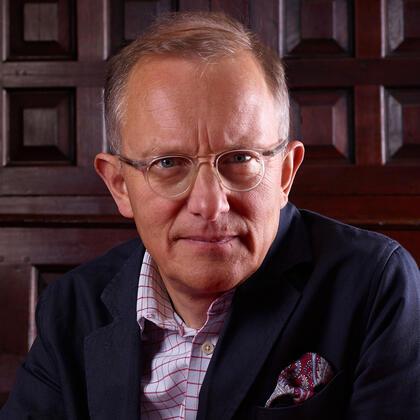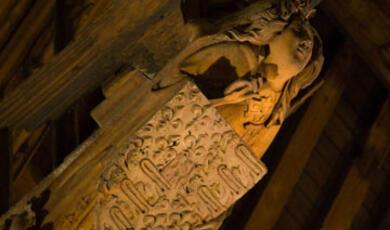Coming to Terms with Modern Times: English architecture in the post-war era
Share
- Details
- Text
- Audio
- Downloads
- Extra Reading
The Second World War intensified and magnified debates that had been current amongst architects since 1914. It also marks a fault line in English architectural history. Architects, supported by politicians, decisively moved away from tradition and sought to create a new language of architecture. Some loved it, but unfortunately the public grew to hate it.
This is a part of the lecture series, English Architecture: Into the Modern World.
Simon Thurley’s four lectures complete his survey of English building from the Saxons to the present day. The theme is modernity and tradition. This is the story of how British architects struggled to find an architectural language that met the needs and aspirations of a society in a state of rapid change while negotiating deep and popular traditions and beliefs. Two World Wars shook the nation producing the seemingly contradictory emotions of nostalgia and progress. Out of this has come the world in which we live.
The other lectures in this series are as follows:
Building the Victoria City: Splendour and Squalor
English Architecture and the First World War
Forwards and Backwards: Architecture in inter-war England
Download Text
6 March 2013
Coming to Terms with Modern Times:
English Architecture in the Post-war Era
Dr Simon Thurley
Since the middle ages there have been three great phases of building in Britain. The classicism of the eighteenth century; the eclecticism of the industrial revolution and the modernism of the welfare state. Tonight I want to talk about the third of these.
Faced with new types of building, from the mid nineteenth century, there were two possible aesthetic responses: Either architects made utilitarian structures such as railway stations fit traditional aesthetics OR they had to seek to change the criteria of beauty to suit the demands of technology. The Victorians did the first. Modernists did the second. To put it another way: either beauty lies in the eye of the beholder or it is inherent to the building itself. So the Victorians argued for extrinsic beauty, beauty came from the associations that came from the various styles of architecture that they plundered for inspiration. The Moderns argued for intrinsic beauty, in other words that the structures themselves contained inherent properties that were beautiful. Beauty was to express the function of a building and its structure, so a new rule of design was developed. Architecture as art was replaced by the architecture of service. An architecture without style where the form was determined solely by the function. Modernism was thus not a style. It was the Holy Grail, the final chapter, the solution to the dilemma of style.
Until 10 years ago historians, people like Nicholas Pevsner and John Summerson believed that Modernism was the inevitable result of progress, the logical conclusion of the development of architectural styles since the 18th century. These people wrote in the aftermath of the Second World War, a war that had collectivised English society. To win the war all aspects of national life had been brought under the control of the state, to a far greater extent than was the case, for example, in Nazi Germany. The lesson seemed to be that with the tools of the new architecture the state could bring a new and better world for the population of Britain. This forward-looking dynamic was not only built on the streets it was enshrined in the history books.
Now not everyone saw this new utopia as a positive force. Returning to the pages of Lord Clark’s book Civilization which he reluctantly published in 1969 to accompany his now famous television series it is apparent that for him civilization stopped in 1914. Well perhaps not stopped, but that after 1914 we entered what he describes as the ‘era in which we are now living’. It was an era in which he felt profoundly uncomfortable. Phrases such as ‘We have no idea where we are going’, and ‘I am completely baffled by what is taking place today’ epitomise an age in which he saw the computer as a tool which a minority could keep the majority in subjection. He summed it up by saying that ‘one must concede that the future of civilization does not look very bright… One might be optimistic’ he wrote, ‘but one can’t exactly be joyful about the prospect before us’.
The lack of joy is entirely understandable if you take as a starting point that civilization rests on the shoulders of the genius of individuals. This, of course was the theme of Clark’s programmes and in 1969 it must have seemed at least questionable whether that was true any longer. Where was the genius in post war England? Safely insulated at Saltwood Castle, his family home in Kent, this hardly mattered, but arriving at Waterloo Station in 1969 one was confronted with the hard fact that after the Second World War architecture in Britain had been nationalised. The state had taken over the patronage of architecture, very few private individuals built in the prevailing modernist style; it was the state, Local and central government, the universities, the post office, the railways who were the patrons of the age. Not only this but the immediate post-war years were a period of economic crisis and rationing so buildings had to be cheap. Lean is perhaps a better word, the strongest possible structures built with the smallest quantity of materials.
So for instance buildings of the 1950s, like the Smithson’s famous school at Hunstanton, had to justify every inch of steel used. [Alison and Peter Smythson’s Hunstanton School Norfolk 1949-54. This is the classic modernist building. Famous for its structural integrity.] As a result they were engineered sparsely, with materials that sometimes have not had long life spans. The original cheap construction of these structures has often been compounded by the almost total lack of proper planned maintenance which has exacerbated the original design faults. Take the Geoffrey Chaucer School; Grade II listed building in Harper Street SE1 designed by Chamberlain Powell and Bon and opened in 1958. Here there is an extraordinary pentagonal assembly hall and a highly innovative gymnasium. They were built pushing the technical capabilities of the materials to their limits, the gymnasia to a design never before contemplated for a school. These structures were experimental. And thanks to changing attitudes to education and catastrophically poor maintenance they are now seen as having failed. Of course sometimes the structure failed from the start like the cladding on the metropolitan cathedral of Christ the King in Liverpool designed by Sir Frederick Gibberd in 1967 or the rainwater drainage systems on the roof of the central pavilion at the Commonwealth Institute in Kensington that had been designed by RMJM in 1962.
But, of course some of the early modernist buildings are very good, I wonder what Kenneth Clark thought of the Royal Festival Hall which, unusually for a modernist building, is genuinely popular with the public. The Festival's commissioning architect, Hugh Casson, appointed Leslie Martin, Robert Matthew and Peter Moro from the London County Council's Architects' Department to design it. It was finished 1951 and given a new front in 1961-4. As I will explain later this is what I would call a recessive building. Especially before it was re-fronted it was light and delicate, almost playful. But the Festival of Britain led to a reaction from architects, almost all of whom were commissioned by government, who hated the frippery of it all, and their anger led to Brutalism.
Take this icon of British modernism the Engineering Building, University of Leicester by James Stirling 1959-63 one of the most influential modernist buildings in the world, uncompromisingly brutalist, it would look at home in Moscow. Park Hill flats, Sheffield by Jack Lynn and Ivor Smith completed in 1961 represent the triumph of the construction of a new Jerusalem. This was the solution to people’s wants and desires, a building provided by the state to allow people to be free inside. Vast, ugly, concrete and collapsing - it still dominates Sheffield. It is probably the most controversial listed building in the UK. Even in the sphere of the arts state patronage produced uncompromising architecture: The south bank devised by the LCC architects and comprising the Purcell Room and the Hayward gallery. No windows, a door deliberately hidden away (no hierarchy) and these buildings designed to contain things to enhance and delight the senses! The National Theatre by Sir Denys Lasdun a much better building in its monolithic grandeur and composition but still brutal.
These individual commissions should be seen in a wider context, that of the destruction of some of the most beautiful medieval and Georgian towns in England: Plymouth, Nottingham, Derby, Leicester, Coventry, and of course the rape of some of our great cities principally London, Birmingham and Manchester.
Their story starts in the middle of the War with a huge burst of optimism. The father of it is Lord Reith. In response to the Nazi bombing of London and Plymouth he commissioned Lord Abercrombie, the greatest planner of his day, to draw up a plan for the reconstruction of these two cities. Reith’s plans trigged a whole series of plans for almost every major town and city in England. Of these early plans only one city was actually rebuilt – Plymouth. Plymouth today encapsulates the dream of the war time planners. A new city dedicated to the department store and the motor car.
Why were so few cities actually redeveloped in the immediate post war years? The answer is that there was a serious shortage of building materials. Sir Stafford Crips instituted massive budget cuts in 1947 stopping public building and it was only in November 1954 when the building licensing system was stopped that a building boom was trigged. The Torys unleashed a whole series of major road and city centre improvement schemes. These were designed by the borough engineers who created the road schemes, the borough planners who set up the framework and commercial architects who filled in the gaps.
Birmingham is a classic example of this and one of the first with a huge sweeping road with massive offices all around. Coventry likewise. It was possible to do these in Birmingham Coventry because the cities actually owned the land.
The extraordinary thing is that the ideas that they were implementing actually came from the 1930’s. In reality many of these schemes would have been put into place in the thirties had the political will, money and motivation been there. Indeed before the war in Bristol we see the first inklings of the brutality of the post war era. A vast motorway cut through Queens Square. So from 1954 to 1974 hardly an English town escaped dual carriageways and massive town centre redevelopment in concrete and prefab tiles. The best and most horrific examples are probably Nottingham, Derby and Leicester but Worcester, Hereford, Huntingdon all come pretty soon afterwards.
And all this was commissioned by the generation of councillors who had the gung ho spirit of the D-day landings.
However in 1973 the whole brutal process came to a grinding halt. Spiralling inflation meant a collapse in public finances and in the background there was massive public protest. The 1969 London scheme for a huge series of motorways was stopped by violent protest marches. 1975 was the European year of conservation. But perhaps even more importantly there was a horrible realisation that the predictions of the early 1960’s had not come to pass. In the 1960’s they believed that the rapid population growth that had been seen immediately after the war would continue. They believed car growth which trebled immediately after the war would continue at a similar rate. In both predictions they were wrong. During the 1970’s, as realisation dawned, public expenditure moved from city centres to motorways in the country side culminating in the building of the M25.
This was an environment fundamentally different from that of the Old Europe whose civilization had been so eloquently chronicled in Kenneth Clarke’s series that I began with. This was a world where, in the realms of architecture at any rate, the state was now patron and the architects were all too often faceless and angry men intent on sweeping away the buildings that had come before. Buildings that represented an old social order which the new politics of the new world would replace.
Perhaps in the matter of fine art, the area in which Clark excelled, the signs were not as strong, although his last programme stopped before the First World War and he elected not to examine contemporary art. He thought it chaotic reflecting an inner chaos caused by scientific discoveries that dismantled the old view of the universe as an ordered hierarchy.
But just as the state captured the patronage of architecture in England so it moved centre stage in the patronage of contemporary art. The balance between artists and museums fundamentally shifted in America in the 1930s. The Museum of Modern Art, opened in 1929, for the first time approached living artists and gave them equivalent status with dead ones. The 1960s saw traditional boundaries dissolve as art moved off the pedestal and out of the frame. Art was now all too often an installation and it was often commissioned not by a private patron but the curator of an art museum. Artists were disconcerted by this change, the massive audiences that patronage of public institutions brought were welcome, but they disliked the shift of artistic power away from the individual.
The moment that the British Public realised that this change had taken place was the purchase by the Tate Gallery of ''Equivalent VIII' by Carl Andre of 1966. The sculpture, which consisted of 120 fire bricks arranged in a rectangular formation, provoked an outcry and became known as 'The Pile of Bricks'. This was a direct challenge to people’s perception of what art was and to the role of a publically funded institution in directing and indeed leading public taste. During the huge museum boom of the 1980s and into the 1990s the Tate gallery X2 and eventually Tate modern became the institution that shaped taste in contemporary art more than any other.
So the state, for the first time began to replace the old structures of individualistic artistic patronage after the Second World War. That is why in some ways museums present a useful illustration of some of the leading architectural concerns of the age. We happen tonight to be sitting in a modernist museum and I thought, we could take this as an example of what I’m talking about.
In the five months between Christmas 1976 and Easter 1977 three major modernist museum buildings were opened. On 2nd December 1976 the Queen opened the new Museum of London on London wall. Gleaming white tiles lying in slices upon the grim brownness of the Barbican podium brickwork greeted the three-quarters of a million visitors who rushed to see it. Two months later on the 2 February 1977 the George's Pompidou Centre in Paris opened to the public. In its first year 6.5m visitors flooded through the notorious building designed by Richard Rogers and others. And on the 19th April 1977 the Yale Centre for British Art in New Haven America, opened. It had been designed by Louis Kahn of Philadelphia, a building of austere concrete with panels of dull pewter-finish stainless steel punctuated by reflective plate glass windows. Each of these structures, even today, seem to challenge the conventional image of a museum as a temple of learning laden with gravitas and tradition. Each was modernism's attempt to address the vexed question of how a late 20th century museum should actually look. Each also express differing approaches to modern architecture.
After the Second World War architects and Museum directors began searching for a way of creating a museum without being bound by the 19th century monumental historic style which was the accepted idea of an appropriate environment for a museum. The search was to find something better suited to the post war world, to a more democratic and egalitarian society and better suited to new ways of showing exhibits.
Most of the important developments in the design of Museums in the first half of this century were in America. This is because while the majority of great European collections were housed in their magnificent nineteenth century homes a large number of private collections were becoming public by will or grant in America and required new permanent buildings. The first of these was the Corcoran gallery of art in Washington as early as 1859, but an increasing number followed as the century turned. I'll just mention a very few, Isabella Stuart Gardiner's collection and charming mansion in Boston created between 1900-1916. In New York, the Pierpont Morgan opened in 1906 and the Frick opened in 1919. In Washington the Phillips gallery of 1921, the Freer Gallery of 1923 and in 1936 Andrew Mellon's National Gallery. All these were built in classical styles in a Euopean tradition of the temple of the arts. But by far the most influential internationally was Frank Lloyd Wright's Guggenheim in New York designed in 1943 and built in 1956-59.
Unlike my other examples this was a modernist building. Most of you can picture it, I'm sure, with its astonishing sculptural external form and its spiral galleries. As we turn to look at what has been built in post war Britain we will see again and again the influence of the Guggenhiem and other American Modernist museums. Now, Modernist museums in Britain, and indeed much of the rest of modernist architecture, In my view, falls into two types ASSERTIVE and RETICENT. The assertive ones belong to a more international school of brutalist modern architecture while the reticent ones are a much more home grown product.
The Assertive modernist buildings tend to be dramatic, sculptural and often aggressive. They are usually physically big or look big. They are, if you like, Museum Macho. Almost all take their cue from Frank Lloyd Wright's Guggenhiem and many adopt the concept of a spiral. Typical of this type of museum building is the GLC's Hayward Gallery of 1968, the ultimate gallery macho sitting squat and muscular nestled amongst its equally brutal neighbours. A less well known example, but equally important in its time is the extension to the Ulster Museum by Francis Pym and local architects to a design of 1963 but completed in 1971. It is an aggressive concrete mass conceived around a spiral with a central void. Perhaps at first sight less brutal is Norman Foster and Associates Sainsbury Centre, Norwich of 1978 built like an aircraft hanger on an enormous scale similar to that of the Pompidou centre itself. It too has the scale and assertiveness of my first group. Over time these buildings have proved to be pretty inflexible, often confusing to visit and navigate and sometimes overbearing and dominating for their collections.
The first of this school, the Guggenhiem itself, is a great building but a frustrating museum, even the arch-modernist Nicholas Pevsner hated it saying it was 'everything a museum should not be'. Mark Girouard wrote of the Ulster Museum in the Architects Journal of February 1972 claiming 'The result is impressive but certainly grim and likely to get grimmer. The Hayward, in the words of a regular user 'has internal spaces that are notoriously awkward' and 'the architecture is insistent and unrelenting'.
Contrasting with the 'macho' of the assertive modernist museums and galleries is my second category of post war buildings the: reticent museums. These are an indigenous product and ignore the need to be seen as European masterpieces. They have an English quality of sensitivity to their surroundings and often compose in a picturesque way. They have small-scale detail, and are characterised by understatement and thoughtfulness. Internally they are designed to be sympathetic to their function and have the modernist love of free flowing space often encased in traditional materials, particularly wood in combination with concrete.
In my view these reticent buildings have provided the most successful museum and gallery spaces in England since the war. The University galleries of the 1960s such as Christchurch Gallery Oxford by Powell and Moya. Designed in its present form in 1978 the British Library is the largest and most complex expression of the reticent type although it was modified later with some post-modern detailing. It sits modestly and neatly on the Euston road, its brickwork indistinguishable in colour from St. Pancras station next door. The architect, Colin St. John Wilson, wrote in his book about the design and construction of the library that assertive modernist buildings 'failed to take account of the human, psychological and symbolic elements at play in all of us' and that his building and the school of reticent modernist architecture to which it belonged had the overriding conviction that 'inspiration must spring from a rigorous factual appreciation of the required conditions and not, _the imposition of preconceived forms and ideas upon the real desires and necessities at issue'. His building was to adopt 'organic forms that are responsive to growth and change' and to have a 'repertoire of sensuous materials' for its interior. All these ideas are present in another reticent building : the Museum of London, designed in the late 1960s and completed after an 11 year construction period in 1976, we will return to this later. Finally, designed in 1971 and completed in 1982, the serene and elegant Burrell Collection by Barry Gasson was opened in Glasgow and is perhaps the apogee of this style. At both the Museum of London and at The Burrell collection an additional powerful influence is that of the medieval cloister another idea developed from an American prototype, the Metropolitan Museum of Art's Cloisters.
In general the critics have treated these buildings kindly if with neutrality. In 1989 Jonathan Glancey wrote in New British Architecture that 'The Burrell Collection is a reticent building that weaves a delightful tapestry with the threads of architecture and nature'. Of the Museum of London an editorial in the Architectural Review explained '(this is) the most retiring public building in London - The supreme virtue of Powell Moya and partners brand of architecture is reticence. Not for them the eye-catching architectural gesture'. After years of vilifying a similarly kind reception had been afforded to the British Library perhaps the ultimate accolade for the reticent moderns.
It was only in the 1990s that we see a decline of modernist solutions to new museum buildings in the UK. Most recent additions and new buildings can loosely be described as post modern, or as I prefer it eclectic. They all share the post modern qualities of mixing traditions, details and allusions at will. One of the principal proponents of this school has been James Stirling who consciously harks back to the classical prototypes of the 19th century, particularly John Soane's Dulwich Picture Gallery. Sadly his best work has been in Germany, his Stuttgart gallery is often claimed as a masterpiece of museum construction. In England The Clore Gallery at the Tate is his best known creation. Neither Stuttgart nor the Clore overtly use the classical language of architecture. The Venturi extension to the National Gallery does and combines it with a post modern use of humour.
But if you will forgive me I’ll return to this building that we are in as an example of modernist design. The site was a bombed out corner of the city on the edge of the new Barbican development. It was the property of the Corporation of London but was to be leased to the Museum for 99 years. The Corporation, in return were to build a 13 storey tower block on top of the Museum which would yield a rent which in time would pay for the grant of the site.
A short list of architects was prepared on the advice of the president of the RIBA, and eventually the architects Phillip Powell and John Moya were chosen over the head of Sir Hugh Casson who the director Tom Hume thought would bring 'endless trouble'. They were appointedin August 1962. Powell and Moya were amongst the finest modernist architects working in Britain in the 1960s. Their best known buildings, love them or hate them, are the Chichester festival Theatre, the Skylon at the 1951 Festival of Britain, The Queen Elizabeth Conference Centre in Parliament square, and University buildings at both Oxford and Cambridge. Powell and Moya believed in fully understanding the requirements of the new Museum and joined a working group to provide a brief. The group went to America and Mexico to look at new museums in 1965 and later travelled to Germany, Austria and Italy. There were two things which came out of the foreign trips. The first was an admiration for the Guggenhiem and an enthusiasm for the spiral, the second was a recognition of the importance of natural light and the use of windows as a means of orientating people round a gallery. Both of these were to become an important element in the final design.
With these lessons in mind the museum director, trustees and the architects completed the brief which to this day stands as a blueprint for the museum. The brief was almost a manifesto for the reticent type of modernist museum that I described earlier. It stated that 'The architectural treatment of the exterior should evolve not only from a happy relationship with the existing and projected surrounding buildings but also from the requirements of the interior of the Museum', in other words it was not to be an aggressive architectural statement. The brief demanded 'a comprehensible and untiring circulation plan' with the objects seen in 'attractive but unassertive surroundings'. It went on to explain that 'museums are too often associated with mental and physical fatigue. To avoid these we believe it is right to provide some form of relief for example, the main public circulation route can be associated with a pleasantly arranged garden_like a cloistered walk'. The first design took all this in and produced a large museum all on one level set around a spacious courtyard. But it was doomed to failure.
Right from the start the hall of the Ironmongers company was a problem. The hall dated from 1924 and thanks to many cups of tea and rounds of sandwiches provided for the Barbican fire brigade was saved when hit by incendiary bombs in 1942 by loyal and grateful firemen. A compulsory purchase order to acquire the hall to make space for Power and Moya's first design was successfully contested by the ironmongers and Powell and Moya were forced to design the museum round the existing building.
This is what has given the museum its extraordinary shape squeezed onto a scrap of land which most architects would not dignify with the title of a site. It was also constrained by the fact that the Ministry of Transport designed a roundabout at its south west corner which meant that the Museum had to be built out over the road and onto the roundabout. Nearly ten years after Powell and Moya were appointed work began on site in April 1971. It was eventually opened by the Queen in 1976. The museum buildings cost £7m and the adjoining walkways and tower, Bastion House, that rose above it another £5m.
Now the fundamental issue we have is that people have never warmed to assertive modernist architecture and the barbican is an interesting mix of assertiveness and reticence. The museum despite its odd design history is a reticent building. Not many think it beautiful, but few people actively hate it. The same cannot be said for the South bank centre. This very day a new scheme has been launched in an attempt to right some of the problems of the south Bank centre to soften it and make it less assertive.
This example brings us to the nub of the issue. I would argue that people didn’t like modernism much before the Second World War and after the war they liked it even less, but it coincided with the post war austerity programme and was really the only style in which people could AFFORD to build. If it hadn’t been for the war modernism would have been a brief fad of the 20s and 30s. But what this caused was a complete aesthetic divorce between architects and the public which has still not been entirely mended. And this is what is very interesting. Previous styles had been brought down by the sneers of connoisseurs; modernism was killed by the common man. People wanted beauty, ornament, colour, they wanted buildings that fitted in they wanted traditional materials. But the architects failed them.
I went last year to the award of the RIBA Gold Medal to David Chipperfield. An architect who interestingly has also built much of his reputation on designing museums. I show you here the rowing and river museum at Henley upon Thames. He said in his acceptance speech that he saw a disfunctionality between the architectural profession and public opinion and that he thought architects were often seen as a sort of nurse pouring medicine down an unwilling client’s throat. Sadly this had been all too often true. But I don’t want to end this series of lectures on a depressing note. For thanks to the efforts of some very good and sensitive architects we are seeing again a happier relationship between designer and the public. While there are still things I personally deeply regret, there are also buildings like John McAslan’s sublime addition to King’s Cross Station which find universal admiration.
© Dr Simon Thurley 2013
This event was on Wed, 06 Mar 2013
Support Gresham
Gresham College has offered an outstanding education to the public free of charge for over 400 years. Today, Gresham College plays an important role in fostering a love of learning and a greater understanding of ourselves and the world around us. Your donation will help to widen our reach and to broaden our audience, allowing more people to benefit from a high-quality education from some of the brightest minds.


 Login
Login







